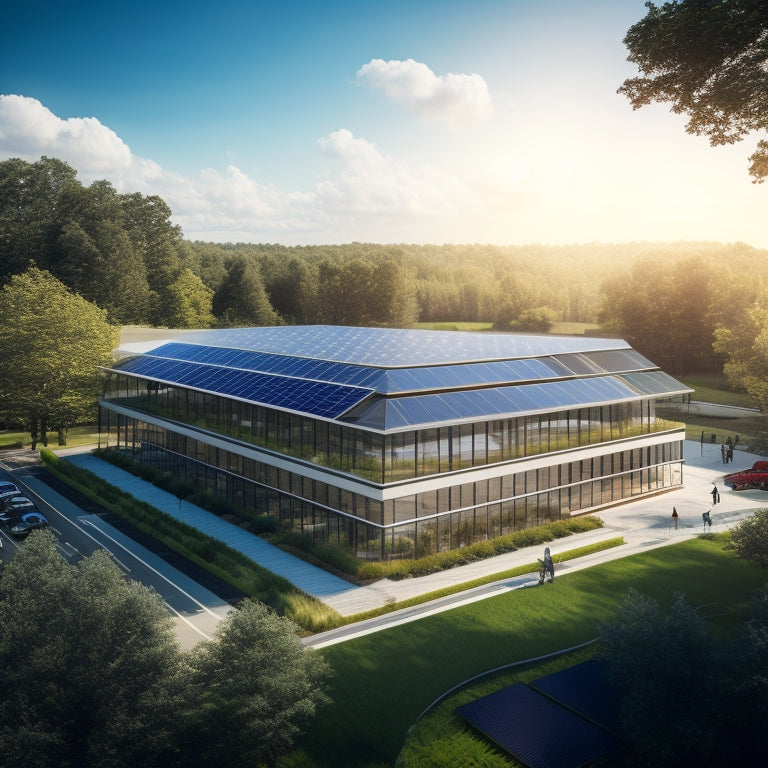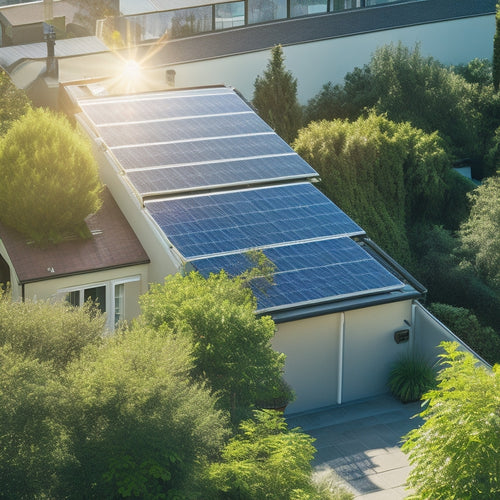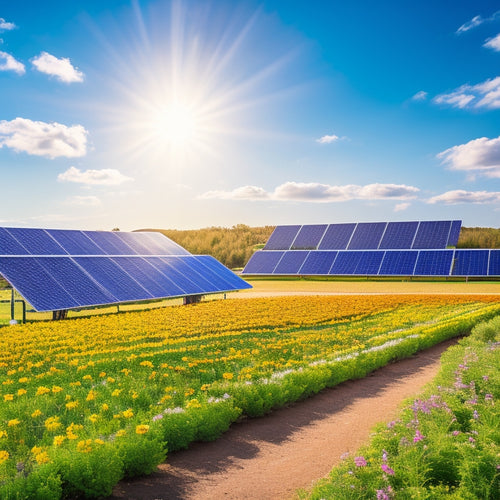
Financing Options for Commercial Solar Panel Systems
Share
When financing commercial solar panel systems, you've got several options. Solar loans offer flexibility with interest rates affecting total costs. Power Purchase Agreements (PPAs) require no upfront investment and provide predictable energy costs. Solar leases simplify budgeting with fixed monthly payments. Commercial PACE financing leverages property tax assessments for funding, while green energy loans feature favorable terms and low interest rates. Tax incentives, such as the Investment Tax Credit (ITC), and utility rebates further reduce costs. Crowdfunding and equipment leasing also present viable approaches, all helping you manage financial impact effectively. Explore these options further to find the best fit.
Key Takeaways
- Solar loans offer flexible terms and potential cost savings by evaluating interest rates and balancing factors to suit financial situations.
- Power Purchase Agreements (PPAs) provide zero upfront investment, immediate cost savings, and predictable energy costs.
- Solar leases feature fixed monthly payments, reducing financial risks and simplifying budgeting.
- Commercial PACE financing uses fixed-rate assessments added to property taxes, leveraging municipal bonds for significant initial capital.
- Green energy loans offer favorable terms with lower interest rates, extended repayment periods, and effective cash flow management.
Solar Loans
Solar loans are frequently a popular financing option for businesses looking to install commercial solar panel systems due to their flexible terms and potential cost savings. When considering a solar loan, it's important to evaluate the interest rates offered by different lenders. Lower interest rates can greatly reduce the overall cost of the loan, making solar installations more affordable in the long run.
Loan terms also play a pivotal role. You should examine the duration of the loan and the monthly payments required. Longer loan terms might result in lower monthly payments, but they can also increase the total interest paid over time. Conversely, shorter loan terms often come with higher monthly payments but result in less interest accrued.
Choosing the right solar loan involves balancing these factors to suit your business's financial situation. Analyzing the total cost of the loan, including both the principal and the interest, is essential. By carefully considering the interest rates and loan terms, you can make an informed decision that maximizes savings and aligns with your business's energy goals.
Power Purchase Agreements
With a Power Purchase Agreement (PPA), you can install solar panels with zero upfront investment, making it an attractive option for budget-conscious businesses. This financing model allows you to benefit from immediate cost savings, as you only pay for the electricity generated at a predetermined rate.
Cost-Saving Mechanism
Power Purchase Agreements (PPAs) offer a strategic method for businesses to reduce upfront costs and mitigate financial risks associated with installing commercial solar panel systems. When you enter into a PPA, a third-party developer installs, owns, and operates the solar system on your property. You agree to purchase the generated electricity at a predetermined rate, usually lower than current utility rates. This setup enhances your energy efficiency by ensuring a consistent supply of renewable energy.
By adopting a PPA, you can notably reduce your carbon footprint. The third-party provider absorbs the installation costs and maintenance responsibilities, allowing you to focus on core business activities. Additionally, your utility bills will likely decrease as you offset traditional energy consumption with solar power.
PPAs also offer predictability in energy costs, which can be particularly advantageous for budget planning. The fixed rate for electricity over the agreement term protects you from fluctuating utility prices. This agreement structure provides clear, measurable benefits in terms of cost savings and sustainability.
Analyzing these aspects, it's evident that PPAs not only offer immediate financial relief but also contribute to long-term energy efficiency and environmental responsibility.
Zero Upfront Investment
Choosing a Power Purchase Agreement (PPA) allows businesses to implement commercial solar panel systems without any initial capital expenditure, effectively removing the financial barriers to renewable energy adoption. With a PPA, a third-party provider installs, owns, and maintains the solar panels on your property. You agree to purchase the electricity generated at a predetermined rate, often lower than current utility rates.
PPAs are an attractive option because they leverage energy grants and renewable subsidies to offset costs. The third-party provider benefits from these incentives, which can include federal tax credits, local energy grants, and renewable subsidies. This arrangement minimizes your financial risk while still enabling you to access the benefits of solar energy.
Moreover, the fixed-rate structure of a PPA shields your business from fluctuating energy prices, offering predictable operational costs. As the provider handles maintenance and performance monitoring, you can focus on core business activities without worrying about the system's upkeep.
Solar Leases
With solar leases, you'll make fixed monthly payments for the use of the solar panel system, allowing you to avoid substantial upfront costs.
The leasing company typically handles maintenance and upkeep, ensuring the system operates efficiently without additional expenses on your part.
This arrangement can simplify budgeting and reduce the financial risks associated with system ownership.
Monthly Payment Structure
Solar leases offer businesses a flexible monthly payment structure, enabling them to install commercial solar panel systems without the significant upfront costs. By opting for a solar lease, you can distribute the financial burden over a set period, typically ranging from 10 to 20 years. This approach includes an amortization schedule, detailing how each payment is allocated towards both the principal and interest, ensuring transparency in your financial planning.
Interest rates play an important role in determining your monthly payments. Generally, lower interest rates result in lower monthly payments, making it essential to compare rates across various providers. The interest rate is often influenced by your business's creditworthiness and market conditions at the time of the agreement.
One of the primary benefits of a solar lease is the predictability of costs. Most leases offer fixed monthly payments, allowing you to budget more effectively. Additionally, some agreements may include an escalator clause, where payments increase slightly each year, reflecting inflation and rising energy costs. This structured approach helps manage cash flow, making solar energy a viable option for your business without straining your finances.
Maintenance and Upkeep
Maintaining and keeping commercial solar panel systems in peak condition under a solar lease agreement guarantees long-term efficiency and reliability. When you choose a solar lease, the responsibility for maintenance often falls on the leasing company, ensuring that your system operates at its best throughout its lifespan. Central to this agreement are warranty coverage and inspection schedules, which play a crucial role.
Warranty coverage under a solar lease typically includes repairs and replacements for any defective components, minimizing unexpected costs for you. This guarantees that any issues are promptly addressed without financial stress, thereby sustaining the system's productivity.
Additionally, leasing companies usually implement rigorous inspection schedules. These regular inspections help in early detection of potential issues, such as panel degradation or inverter problems, allowing for timely interventions.
Commercial PACE Financing
Commercial PACE (Property Assessed Clean Energy) financing provides businesses with a viable means to fund solar panel installations through long-term, fixed-rate assessments added to their property tax bills. This innovative financing model leverages municipal bonds to offer substantial initial capital without requiring upfront costs. As a business owner, you'll benefit from local incentives that can greatly reduce the overall expense. These incentives often come in the form of tax credits or rebates provided by your local government, further enhancing the affordability of your solar investment.
The primary advantage of Commercial PACE financing is that it aligns repayment terms with the lifespan of the solar panel system, often extending up to 20 or 30 years. This extended timeframe means that the savings generated from reduced energy bills can offset the cost of the loan, making the investment cash-flow positive from the outset. Additionally, because the financing is tied to the property rather than the business owner, it can be transferred to new owners if the property is sold.
Moreover, the fixed-rate nature of these assessments ensures that your monthly payments remain predictable, helping you manage your financial planning more effectively. By utilizing PACE financing, you're not only investing in renewable energy but also enhancing your property's value and sustainability.
Green Energy Loans
Green Energy Loans present another compelling financing option for businesses looking to invest in commercial solar panel systems, offering favorable terms and often lower interest rates compared to traditional loans. These loans are specifically designed to support sustainable projects, making them an attractive choice for companies committed to reducing their carbon footprint.
Interest rates for Green Energy Loans are generally more competitive because lenders recognize the long-term value and reduced risk associated with renewable energy investments. Additionally, these loans often come with extended repayment terms, allowing your business to manage its cash flow more effectively while paying off the loan. This can be particularly advantageous if you're looking to minimize upfront costs and spread the financial impact over a longer period.
Detailed analysis of various Green Energy Loan programs will reveal differences in eligibility criteria, loan amounts, and specific conditions tied to the use of funds. It's essential to examine these factors closely to find a loan that aligns with your financial goals and operational needs.
Tax Incentives and Credits
Exploring the landscape of tax incentives and credits can greatly decrease the overall cost of installing a commercial solar panel system, making it an essential consideration for businesses.
One of the most significant Federal incentives available is the Investment Tax Credit (ITC), which allows you to deduct a portion of your solar installation costs from your federal taxes. As of now, the ITC provides a 26% tax credit for systems installed in 2022, with a planned reduction to 22% in 2023.
Depreciation benefits also play an important role. Under the Modified Accelerated Cost Recovery System (MACRS), businesses can recover investments in solar equipment through depreciation deductions. Coupled with the ITC, MACRS allows you to notably reduce taxable income, thereby decreasing the payback period for your solar investment. Bonus depreciation, which permits you to depreciate 100% of the cost in the first year, is another compelling advantage.
Additionally, various states offer their own tax incentives, which can further decrease the net cost of your system.
Utility Rebates
Utility rebates can greatly offset the initial costs of installing a solar panel system, making it a viable and cost-effective option for businesses. Utility incentives are offered by many energy providers to promote the adoption of renewable energy. These rebate programs can reduce your upfront investment substantially, thereby improving the return on investment (ROI) for your solar project.
When considering utility rebates, it's essential to understand the specifics of the available programs. These often vary by location and utility company. Some rebates are based on the size of the system installed, while others might be performance-based, rewarding you for the energy your system generates over time.
Here's a quick overview to help you compare different utility rebate structures:
| Rebate Type | Description |
|---|---|
| Capacity-Based | Rebates based on the installed system's size. |
| Performance-Based | Incentives tied to the actual energy produced. |
| Flat-Rate | A fixed amount provided regardless of system size. |
Each type offers distinct advantages and can impact your financial planning differently. By leveraging these utility incentives, you can lower your capital expenditure and accelerate your break-even point. Always check the specific terms and conditions of rebate programs in your area to maximize your benefits.
Crowdfunding
Crowdfunding offers an innovative way to finance commercial solar panel systems by pooling small contributions from a large number of individuals, thereby mitigating the financial burden on a single entity. When you leverage crowdfunding, you tap into community support, which can be particularly effective if the project has a strong local or environmental impact.
By creating investment pools, you can gather the necessary capital without relying on traditional financing methods that may come with stringent requirements or high-interest rates.
To launch a successful crowdfunding campaign, you'll need to communicate the benefits of your commercial solar panel project clearly. Highlighting the potential for reduced energy costs, environmental sustainability, and community resilience can attract a broad base of contributors. Platforms like Kickstarter or GoFundMe provide the infrastructure to collect and manage these funds efficiently.
Additionally, offering incentives such as recognition plaques or future energy credits can motivate more individuals to invest. By building a sense of ownership and involvement, you not only secure funding but also foster a supportive community around your project.
This method democratizes the investment process, making it accessible for those who mightn't have the means to contribute large sums but still want to support renewable energy initiatives.
Equipment Leasing
While crowdfunding can democratize investment, equipment leasing offers an alternative strategy to finance commercial solar panel systems without the need for substantial upfront capital. By opting for equipment leasing, you can mitigate the high capital requirements often associated with purchasing solar panels outright. This approach allows you to conserve your cash flow and allocate resources to other critical business operations.
In equipment leasing, you enter into a contract with a leasing company, which then owns the solar panels and leases them to you for a specified period. The lease terms can vary, typically ranging from 5 to 20 years. These terms will outline the monthly payments, maintenance responsibilities, and options for purchasing the equipment at the end of the lease. It's essential to thoroughly review these terms to ensure they align with your financial projections and operational needs.
One key advantage of leasing is the potential for reduced maintenance costs, as many leasing agreements include maintenance services. However, you won't benefit from certain tax incentives available to owners of solar systems.
Frequently Asked Questions
How Do I Assess the ROI of a Commercial Solar Panel Investment?
To assess the ROI of a commercial solar panel investment, calculate energy savings, then determine the payback period by dividing the initial investment by annual energy savings. Compare this to your required ROI threshold for informed decision-making.
What Are the Hidden Costs of Installing Commercial Solar Panels?
You might think installation is straightforward, but coincidentally, hidden costs like permitting fees and grid connection expenses can surprise you. These additional costs can greatly impact your budget, making a detailed analysis essential.
How Do Solar Panels Affect Property Value in Commercial Real Estate?
Solar panels can boost commercial property value by providing significant energy savings and demonstrating a positive environmental impact. Prospective buyers often value the reduced operational costs and sustainability, making your property more attractive and marketable.
Are There Any Industry-Specific Financing Options for Solar Panels?
Exploring the labyrinth of financing, you'll find shimmering government grants and robust leasing programs tailored for your industry. These options open doors, making solar panel investments more accessible and feasible for your commercial ventures.
What Is the Typical Maintenance Cost for Commercial Solar Panel Systems?
You can expect typical maintenance costs for commercial solar panel systems to be around $15-$25 per kW annually. Cleaning frequency and warranty coverage greatly impact these costs, with regular cleaning and good warranties reducing unexpected expenses.
Conclusion
You've explored various financing options for commercial solar panel systems. Now, the question lingers: which path will you choose to harness solar power's potential?
Each avenue offers unique benefits and challenges. Will it be the flexibility of solar loans, the simplicity of leases, or perhaps the long-term advantages of tax incentives?
The decision holds the key to not only your energy future but also significant financial impact. Choose wisely, as the stakes couldn't be higher.
Related Posts
-

Off-Grid Solar Solutions for Sustainable Farming
Off-grid solar solutions can revolutionize your farming operations by providing energy independence and significant c...
-

How Solar Panels Reduce Electricity Bills
Solar panels can drastically cut your electricity bills by utilizing sunlight to generate your own energy. This decre...
-

High-Performance Solar Solutions for Sustainable Living
High-performance solar solutions are your gateway to sustainable living, maximizing energy efficiency while considera...


